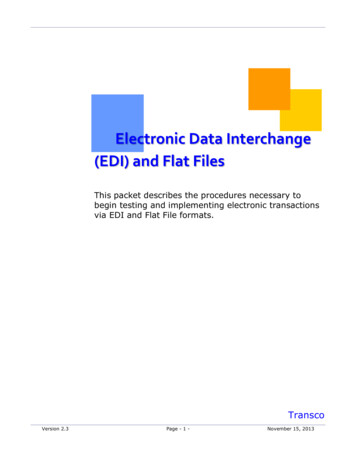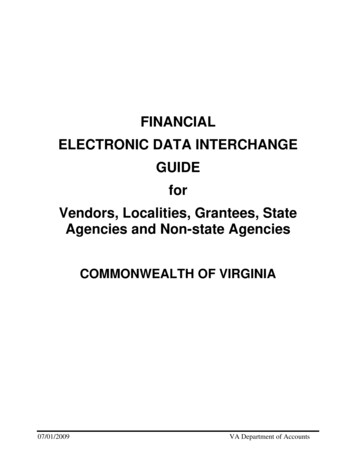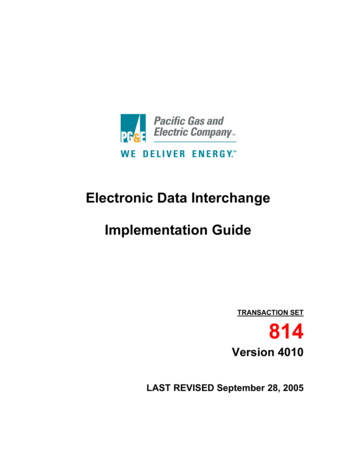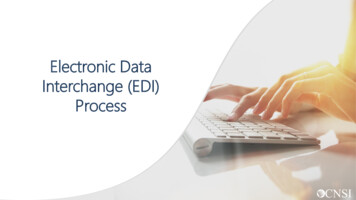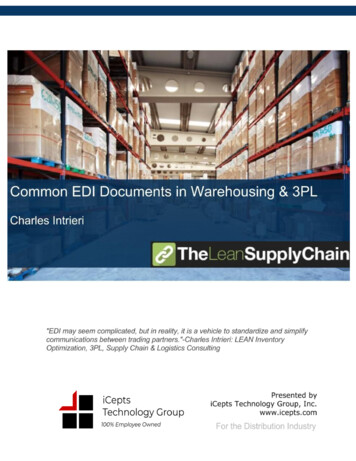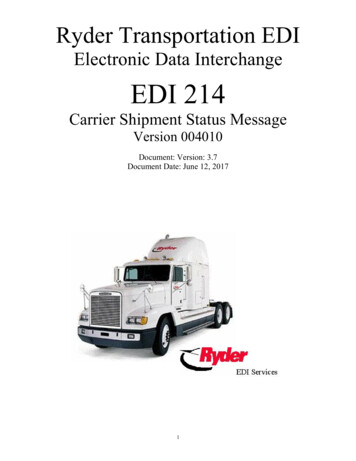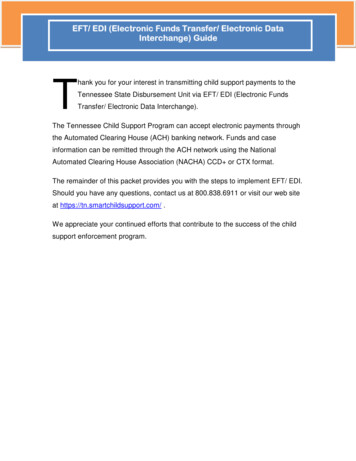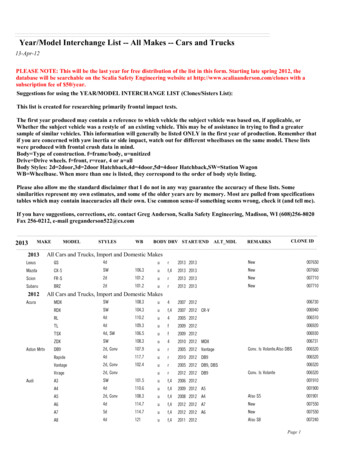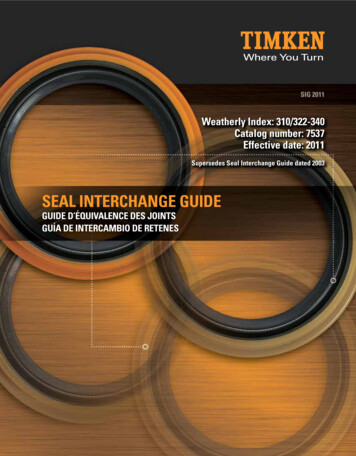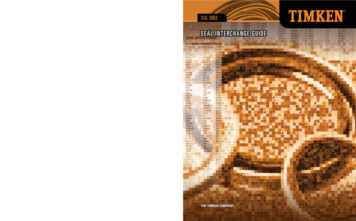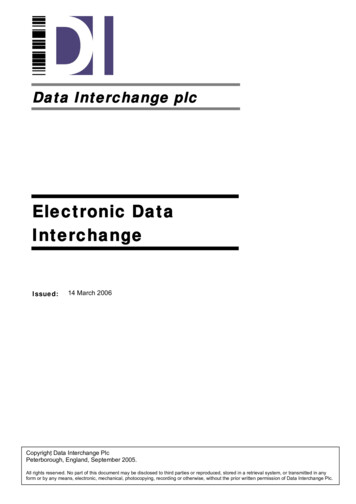
Transcription
Data Interchange plcElectronic DataInterchangeIssued:14 March 2006Copyright Data Interchange PlcPeterborough, England, September 2005.All rights reserved. No part of this document may be disclosed to third parties or reproduced, stored in a retrieval system, or transmitted in anyform or by any means, electronic, mechanical, photocopying, recording or otherwise, without the prior written permission of Data Interchange Plc.
Table of ContentsElectronic Data Interchange. 5What is EDI?. 5Urgency Issues .5Communications .6The Move To Standardised EDI.6The EDI Model. 7VDA Standard .8Syntax Standards . 9Service Segments .10Segment Delineation Characters .11Streams of information .12Message Standards . 12EDI Codes and Routing . 14Introduction .14EDI Routing.14Routing Nodes .15The Hierarchy of Node Types .16EDI codes in ODEX Enterprise .17EDI Codes for Clearing Centres .17The Makeup of an Odette/EDIFACT EDI Code .17The Makeup of a Tradacoms EDI Code .18VDA EDI Codes .19Encoding standards . 19Introduction .19ASCII 20EBCDIC.21Unicode .21File encoding in DI products .22
4Electronic Data Interchange
Electronic Data InterchangeWhat is EDI?For several hundred years, commerce has been based upon themovement of written documents. These documents contained theinformation that one company needed to convey to another company inorder to do business. Over a period of time the documents started totake on standard names such as Invoice, Credit Note and Order.However, the documents were certainly not of any standard layout. Theydid not need to be because the recipient was always a human being andhumans have the ability to read, interpret and rationalise. About all thatcould be said of an invoice document, for example, was that it wouldcontain header information about the parties involved, detail lines aboutthe products, quantities and prices, and finally some totalling information.In the early 1950s, computers started to be used by large companies fortheir accounting and payroll needs. Throughout the following decades,computers rapidly took over task after task until they were involved notonly in accounting, but in production, administration and all other areasof commerce. But one thing did not change. The computers stillproduced printed documents in various non-standard formats.This situation was not too bad for those sending a document but wasmuch worse for the receiver. Many documents must be sent from onecompany’s computer to their trading partner’s computer. Computerscannot easily read written documents, and getting them to understandwhat they have just read is an almost impossible task, so the receivingcompany would have to employ personnel to re-key the information fromthe received documents into the company’s computer system.Urgency IssuesThe time factor was also a problem. The company sending the documenthad printed it in a few seconds. It was placed in an envelope and thenposted. The document would probably take several days to reach theElectronic Data Interchange5
final destination (always with the possibility of accidental loss) where theenvelope would be removed and the document presented for keying in toanother computer.For a long time, managers had been thinking how good it would be tohave “Just in Time” production techniques, where a supply lorry would beable to arrive at the production line gates just in time to be unloaded andits contents taken directly to where they were needed on the productionline. They dreamed of an end to costly warehousing and stock control.But these methods were impossible while the trading partners were stillusing the post. Lorries would be arriving at the wrong times, or not at all,causing the production lines to stop and chaos to reign, all because ofthe delay in the information flow.CommunicationsPart of the answer to these problems was computer communications andthe need to make one trading partner’s computer “talk” to another.Communications have been in existence since the early days ofcomputers. A file can be transmitted from one computer to another,either over a normal telephone line or over a “Leased Line” that iscontinuously in use and dedicated to computer communications. Manycommercial products exist that can move files in this way.Communications did not solve the whole problem though. Once a file isreceived it needs to be understood by the receiving computer. Items ofinformation must be in the exact place that the computer is expectingthem. If just a single character is out of place, the whole file will becomeuninterpretable by the computer.In the early days of communications, trading partners had to spend agreat deal of time agreeing exactly where each item of information wouldbe stored in the files that were transmitted. These agreements were onlyactive for one trading partner. Start trading with another partner and therequirements would change slightly, a larger product code wouldperhaps be needed, or a different method of pricing, but the wholenegotiation and agreement process had to take place all over again. Itkept the programmers busy but did little for the company profits.The Move To Standardised EDIThe solution was EDI, Electronic Data Interchange, a standard method oftransferring commercial information between computers.The MessageEDI (Electronic Data Interchange) files contain information, in one ofmany possible formats, pertaining to commercial documents. Forexample, a paper invoice will always contain certain informationwhatever the company or country of origin. It will contain the originatingand receiving company’s information such as addresses, telephonenumbers, contacts, etc. It will then have a section where the items to be6Electronic Data Interchange
invoiced are laid out in a formatted manner, with prices and quantities,and finally it will have a totals section. All this information may becontained within an EDI file of a pre-defined format, so that whoeverreceives the file will be able to understand it and automatically pass thisinformation into their own in-house systems, irrespective of the type ofcomputer or the systems that they are running.The Standards BodiesA number of different standards bodies were created to define bothmethods of communications and the layout of standard tradingdocuments, so that simple and cost effective electronic trading couldtake place. The main document standards with which we will beconcerned are EDIFACT, Tradacoms and ANSI X12, but before goinginto detail about the standards themselves, here is a short background tothe development of the UK documents standards bodies.The earliest development of standards, usually for particular sectors ofindustry, was carried out in the late 1970’s under the auspices of theEAN. EAN is the International Article Numbering Organisation dealingwith EDI standards. It acts as an umbrella group for the various nationalNumbering Organisations.In 1998, as a result of the merger of the Article Number Association(ANA) and the Electronic Commerce Association, the e.centreUK waslaunched as the EAN Numbering Organisation for the UK.More recently, in February 2005, the e.centreUK has become GS1 UK.This is in line with the global re-launch of EAN International as GS1.The first UK message standards were published by the ANA in 1982,having been tested and developed since 1979. Over 90% of all UK tradeEDI takes place using standards from the ANA, whose members includerepresentatives from manufacturing, distribution, wholesaling, serviceand retail organisations.The ANA standards use the two key syntaxes: UN/GTDI (General Trade Data Interchange), which forms the basisfor TRADACOMS messages; UN/EDIFACT (EDI for Administration Commerce and Transport),which is the basis for EANCOM and UK EDIFACT messages.Further details about message syntax are in the sections that follow.The EDI ModelThere are three logical levels or “layers” of standards required to achieveEDI information transfer, each layer having its own controlling standardsorganisations (although some organisations may define more than onelayer). This structured approach to EDI allows for the maximum flexibilityElectronic Data Interchange7
and also enables future developments in technology and standards to beeasily incorporated.From the lowest layer upward, these three layers are: The Communications Standards - Defining just how the data is to betransferred from the sender to the receiver. The Syntax Standards - Defining what overall standards format theEDI file will be in. The Message Standards - Defining exactly what the message is andwhat information is to be placed where within this message.These standards are going to be further described in the followingsections but it is important to remember that whatever standards areused within each layer, the layering process is required to allow flexibility.For example not all users will wish to use a specific communicationprotocol; some may even wish to copy the data onto a floppy disk andsend it in the post! So the communications level is now a floppy disk butthe higher levels still remain.This principle of multiple methods of achieving the same goal is foundover and over again within the EDI regime. It is not an attempt atduplication but is designed to give users the best possible solution andflexibility in all cases.The Communications Standards are described in a section of their own.VDA StandardIt should be noted that VDA messages are treated as non-EDI files bymost members of the ODEX family. This is because VDA messages arenot true EDI messages.8Electronic Data Interchange
VDA stands for Verband der Automobilindustrie (Motor IndustryAssociation). The VDA is a German automotive standards body whichissues the VDA standard documents. VDA messages are not strictly EDImessages as they are simply flat files. Instead of using specialcharacters to divide each segment from the next and each data elementfrom the next, a VDA message consists of fixed length records withinwhich each data element (field) is allowed to take up a specific numberof characters. If any item of data is omitted, its absence must be shownby a space the same length as the omitted item of data.Furthermore, VDA messages do not contain service segments, so thereis no concept of interchange or group. However, the first record in a VDAmessage does contain addressing information of a kind and cantherefore be used by an intelligent program such as ODEX Enterprise orDARWIN for routing purposes.There are enough similarities between VDA messages and true EDImessages to allow VDA messages to be treated by some programs asEDI. VDA messages have a hierarchical structure, meaning that recordswithin a message must adhere to certain rules about the position inwhich they may appear. VDA records, like EDI segments, also haveattributes such as a name, a maximum number of times they may occurand whether their occurrence is mandatory or conditional.Owing to the differences that exist between the VDA standard and realEDI standards, VDA messages are usually treated as non-EDI files.However, ODEX Enterprise and DARWIN 3 have been programmed torecognise VDA messages and to treat them as if they were real EDImessages.Syntax StandardsThe middle level in our three layer EDI model is the Syntax Standard tobe used. Taking the analogy of a telephone call, it is no use if the call isconnected but the remote party does not speak the same language asthe caller; a few minutes will be lost whilst each side tries to understandthe other but no meaningful information may be exchanged.To avoid this problem, three main syntax standards are used for EDI.These are the American ANSI X12 standard, the European EDIFACTstandard and an older European standard still very popular in somesectors such as the retail industry, UNGTDI (United Nations Guidelinesfor Trade Data Interchange). There is also the VDA syntax standard,used in Germany. Although not strictly EDI, VDA messages have beenincluded under the EDI umbrella.With the exception of VDA, no matter what standard is used, the sameEDI terms and concepts apply. Let us now look at these terms and whatthey mean in more detail.Electronic Data Interchange9
An EDI “Message” may be split up into a number of logical units. Themessage is itself a single document such as an invoice or an order, andis made up of a number of “Segments”. Each segment contains completeinformation about a part of the document. For example two segmentsthat will be required in an invoice message are the buyer’s and seller’sdetails. Segments can themselves be split down into “Data Elements”.Data elements hold the actual information. Simple data elements holdonly one item of information, such as a name or a value. Composite dataelements hold one or more “Sub-Elements” of closely associatedinformation such as the lines of an address.EDI messages between two trading partners may be grouped togetherinto an “interchange”. The interchange may contain messages of varyingtypes, the only common factor being the sending and receiving parties.All EDI files must contain at least one interchange; this ensures that theinterchange can be routed to the correct destination.Messages of the same type can be held together in a “group”. Thefunctional group is not a very widely used vehicle, most partnersconsidering that as the interchange is the main routing method and maycontain many messages, then the group is somewhat superfluous.Different standards call the group different names. The group itself is anEDIFACT term, UNGTDI standards know it as a “batch” and ANSI X12standards as a “document”. ANSI X12 also calls the message a“transaction”.Service SegmentsInterchanges, groups and messages are identified in an EDI file byspecial segments known as service segments. Service segments containthe information necessary to route the interchange towards its finaldestination, to identify the contents of the interchange, its date and timeof production, standards used and much more. Remember that theinterchange may be passing through several different routing agencies,just as a letter is passed to and through the post office before reachingits final destination. EDI is not always a point-to-point matter. The service10Electronic Data Interchange
segments act in the same way as the envelope and enclosed documentheadings used in paper correspondence.Service segments enclose a block of segments that they are defining. Inother words there will be service segments both at the start and end ofeach interchange, group and message. The service segment’s namesare different for each syntax standard. The following is a list of servicesegment types and their equivalents for each of the common standards.UNGTDIEDIFACTANSI X. 12Start ofInterchangeSTXUNBISAStart of GroupBATUNGGSStart ofMessageMHDUNHSTEnd ofMessageMTRUNTSEEnd of GroupEOBUNEGEEnd ofInterchangeENDUNZIEASegment Delineation CharactersObviously some method is needed to indicate the end of one segmentand the start of the next, and likewise for the end of one data elementand the start of the next. The manner of achieving this is by segmentdelineation characters. These characters are used to split the EDI file upinto its constituent parts. Each syntax has its own default delimiters, i.e.those that are used if no others are specified, but in most cases thesecan be overridden by special means if necessary.The default segment delineation characters that are used for the mainthree EDI syntaxes that we are considering are given in the followingtable.UNGTDIEDIFACTANSI X12End of Segment‘‘FS (X’1C)or End of Element GS (X’1D)or *End of Sub-Element::US (X’1F)Character ?ControlEscapeElectronic Data Interchange11
Streams of informationThe use of service segments not only allows routing of EDI data betweentrading partners but also allows the concept of regular data “streams” tobe implemented, allowing the trapping of missing data and regularactivities to be performed on EDI interchanges.Interchanges from each trading partner may be identified by the contentsof the interchange control segment. A sequence number in the segmentallows the receiver to check that this interchange is greater than the lastone, avoiding possible duplication, and also allows for missingsequences and hence missing interchanges to be identified.In real life these cases may be more complex. Routing via a VAN maycause some interchanges to be received out of sequence. This scenariowould be similar to the post arriving at your premises. The post isdumped in an unsequenced pile in the mailbox and the letters are thenopened in any sequence. There is no guarantee that the sequence ofdocuments processed or “opened” is correct.To solve this problem the concept of a sequence “window” is used. Solong as the increase in the application reference number is not greaterthan the window size, then all is well and the sequence may then bechecked for missing numbers at a later time when all the documents areexpected to have been received.Message StandardsIn our telephone analogy, our telephone callers may exchangeinformation because both parties are speaking the same language andunderstand the protocols that they must use, b
The solution was EDI, Electronic Data Interchange, a standard method of transferring commercial information between computers. The Message EDI (Electronic Data Interchange) files contain information, in one of many possible formats, pertaining to commercial documents. For example
